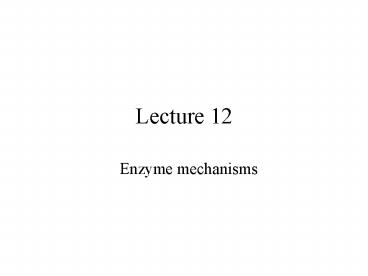Enzyme mechanisms - PowerPoint PPT Presentation
1 / 26
Title:
Enzyme mechanisms
Description:
Lecture 12 Enzyme mechanisms Common enzyme reactions Common enzyme mechanisms More common enzyme mechanisms Example of reactions Lysozyme Discovered by Fleming, 1922 ... – PowerPoint PPT presentation
Number of Views:95
Avg rating:3.0/5.0
Title: Enzyme mechanisms
1
Lecture 12
- Enzyme mechanisms
2
(No Transcript)
3
Common enzyme reactions
Oxidation and reductions (cofactors are involved!)
(Oxidation of an alcohol to a ketone)
B
NAD
4
Common enzyme mechanisms
Isomerizations
B
5
More common enzyme mechanisms
Making and breaking C-C bonds
Aldol condensation
O
B
H
C
C
6
Example of reactions
Phosphorylation/ dephosphorylation
7
Lysozyme
- Discovered by Fleming, 1922
- Lyses the cell wall of bacteria by cleaving the
polysaccharides in bacterial cell walls
8
Lysozyme specificity
- Hexamer (or longer) of sugars binds
- 4th sugar residue must be distorted
- Cleaves between the 4th and 5th
- sugar
9
Lysozyme mechanism
General acid base catalysis Stabilization of
carbocation
10
Lysozyme mechanism
11
Covalent Catalysis by Enzymes
- Formation of acylserine intermediate by
chymotrypsin
12
Covalent Catalysis by Enzymes
13
Identifying Covalent Catalysis
Identical rates reflect rate-limiting breakdown
of a common intermediate
14
Mechanism and rate
ENZYME
fast
O
ENZYME
O
C
Acyl-enzyme intermediate
H2O
slow
H
-
ENZYME
15
Identification of catalytic residues
ENZYME
ENZYME
Only serine 195 reacts with DIPF (no other serine
in the protein reacts)
Irreversible reaction inactivates enzyme
16
Catalytic Triad
- Ser195 - Nucleophile
- His57
- Asp102
General acid and base catalysis
Serine proteases (esterases) all have similar
mechanisms.
17
Catalytic Triad
18
Chymotrypsin
- pH-rate profile
19
Chymotrypsin Mechanism
20
(No Transcript)
21
(No Transcript)
22
(No Transcript)
23
(No Transcript)
24
(No Transcript)
25
Hexokinase
- Mr 100,000
- Glucose gtgt H2O 106
- ATP Glucose ADP
Glucose-6-Phosphate
26
Hexokinase Mechanism
- Induced fit
- Glucose unbound































